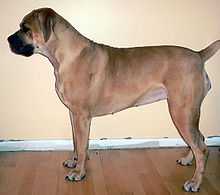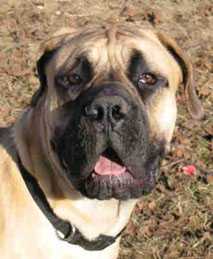Boerboel
 | ||||||||||||||||
| A registered Boerboel in profile | ||||||||||||||||
| Other names | South African Boerboel South African Mastiff | |||||||||||||||
|---|---|---|---|---|---|---|---|---|---|---|---|---|---|---|---|---|
| Country of origin | South Africa | |||||||||||||||
| ||||||||||||||||
| ||||||||||||||||
| Dog (Canis lupus familiaris) | ||||||||||||||||
The Boerboel [burbul] is a large, mastiff dog breed from South Africa, bred for the purpose of guarding the homestead. These dogs were often a first line of defense against predators such as lions, hyenas and other big cats and were valuable in tracking and holding down wounded game. Old farmers tell many tales of the strength, agility, and courage of their Boerboels.
Breed history
The word "Boerboel" derives from "boer", the Afrikaans/Dutch word for "farmer". Boerboel, therefore, translates as either "farmer's dog" or "Boer's dog". The Boerboel is the only South African dog breed created to defend the homestead.
Despite the Boerboel's long breeding history, there is great uncertainty as to how many and which breeds were used to create it. It is generally believed that the breed was created from interbreeding native African canine species with breeds brought into South Africa from Dutch, French, and British settlers.
The most likely origins are claimed to date back to Jan van Riebeeck’s arrival to the Cape in 1652. Van Riebeeck brought a "Bullenbijter" with him.[1] Those with him, and later European settlers, also had large, strong dogs, that almost certainly bred with the indigenous, domestic dog breeds of South Africa.[2][3]
Later, in 1928, the diamond mining company De Beers imported Bullmastiffs to South Africa to guard the mines. This breed was also crossbred with Boerboels in the region.[1]
Boerboels today
The Boerboel Breeders Association was established in 1983 in the Senekal district of the Free State with the sole objective of ennobling and promoting the Boerboel as a unique South African dog breed.
Today, Boerboel breeding is both a hobby and an industry in South Africa. These dogs are now exported from South Africa to other parts of the world.
The protective character of the Boerboel is still evident and is much sought after, as is the calm, stable, and confident composure of the breed. The dogs are obedient and intelligent and have strong territorial instincts. The Boerboel remains the guarding breed of choice amongst current day farmers and is very popular for the same reason in urban communities.[4]
The name boerboel is commonly misspelled as boerbul, boerbull, and borbull.[5]
In 2010, the Boerboel was banned in Denmark for being a fighting dog.[6]
Description
Appearance

Coat
The Boerboel is an average shedder and easy to groom. The occasional brushing and a monthly bath and nail trim is all that is needed. The breed has an outer coat that is normally coarse and straight, and an undercoat that is soft and dense.[7]
Its coat is short, dense, smooth, soft, and shiny. Their coat color can be various shades of red, brown, or fawn. Many dogs have a black mask around their mouth that sometimes extends to their eyes and ears. The Breed Standard colors for the Boerboel is Fawn, Light Fawn, Red all colors of red and Brindle
Temperament
Boerboels are an intelligent and energetic breed.[3] They are loyal, great with kids and tend to be protective of their family and territory.[7][8]
They are quite charming when not being lazy, and will not hesitate to defend their loved ones to the death.[3]
Health
Boerboels are generally known for their good health. However, Boerboels can suffer from hip[9] or elbow dysplasia, vaginal hyperplasia,[10] ectropion, and entropion.[2][8] Recently, juvenile epilepsy (with attacks brought on by metabolic changes or stress) has appeared in the boerboel breed.[11] The average life expectancy is ten years.[12]
Requirements
Prospective owners must recognize that owning a boerboel requires a significant commitment in time and energy as they need to be trained and properly socialized in order to be happy, well-adjusted family members.[2][7][8]
These dogs thrive under positive reinforcement training techniques and require human companionship and structure. If left isolated, Boerboels will digress and may become destructive. Owners should be wary of trying to forcefully control the dog as it is detrimental to their psychological health and could cause potential behavioral backlash in the future. These dogs benefit from an owner who respects their size and strength but is not fearful of it.
If you are considering adding a boerboel to your family or already own a boerboel and are thinking of moving (to a smaller home), remember this – bored boerboels are destructive boerboels and at 150 lbs, can do a lot of damage. Although more suitable for large yards, Boerboels are adaptable and can live in small environments as long as they receive regular exercise and a lot of attention. Whatever the amount of space available, they need to have plenty of physical and mental exercise.[2] The Boerboel can be exercised in a large, securely enclosed yard, but at a minimum this type of dog needs to be taken on a long walk every day. According to the vast majority of Boerboel breeders, this dog should only be off leash when on its property.[citation needed]
See also
- Animal Socialization
- Boerboel International
- Fédération Cynologique Internationale
- Guard dog
- Kennel Union of South Africa
- Molosser
- Obedience training
- History of South Africa – Colonization (1652–1815)
References
- ↑ 1.0 1.1 "Breed standard (Appendix A)". Sabt.co.za. Retrieved 2012-09-18.
- ↑ 2.0 2.1 2.2 2.3 Breed Description
- ↑ 3.0 3.1 3.2 "Know the Boerboel sabt.co.za" (PDF). Retrieved 2012-09-18.
- ↑ "Preamble of Official Breed Standard of Boerboel International Boerboel International Breed Standard". Boerboelinternational.eu. Retrieved 2012-09-18.
- ↑ Lance Rose. "This South African Boerboel site is intended to be your resource to everything Boerboel-related on the internet. The Boerboel is a rare breed, it is not recognized by the AKC or the CKC and finding quality information can be difficult. If you're looking for Boerboel puppies, studs, breeders, message boards, books, kennels, health information, shows, registries, or anything else Boerboel, you'll find it here! South African Boerboel Directory and South African Boerboel Breeders". Dogresources.com. Retrieved 2012-09-18.
- ↑ Ritzau /Nyheder, Mette Pedersen (2011-01-19). "Ekstra Bladet - 13 kamphunde forbydes". Ekstrabladet.dk. Retrieved 2012-09-18.
- ↑ 7.0 7.1 7.2 "Boerboel Dog & Puppies Boerboel – Dog of the Boers". Dog-names.org.uk. Retrieved 2012-09-18.
- ↑ 8.0 8.1 8.2 "Buying a Boerboel sabt.co.za 10 March 2009" (PDF). Retrieved 2012-09-18.
- ↑ "New Hip Dysplasia Grading System sabt.co.za 3 June 2007" (PDF). Retrieved 2012-09-18.
- ↑ "Vaginal hyperplasia sabt.co.za 12 July 2007" (PDF). Retrieved 2012-09-18.
- ↑ "Epileptic research Dr Quirine Stassen, veterinary surgeon, research worker, internal medicine – neurology university clinic for household pets". Babelfish.yahoo.com. Retrieved 2012-09-18.
- ↑ Lynne Berridge copyright 2004. "Accolade Boerboels". Boerboels.co.uk. Retrieved 2012-09-18.
External links
| Wikimedia Commons has media related to Boerboel. |
- American Boerboel Club
- Boerboel International
- The UK Boerboel Club
- SABBA USA
- SABBA/SABT
- The Norwegian Boerboel Assosiation
| ||||||||||||||||||||||||||